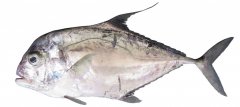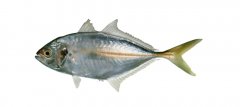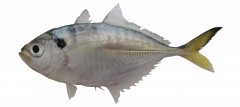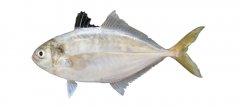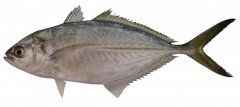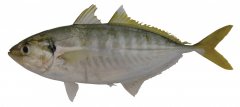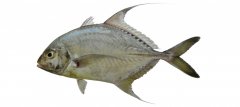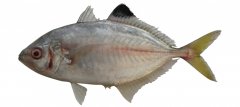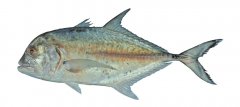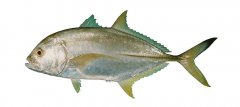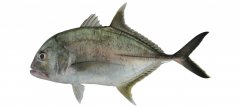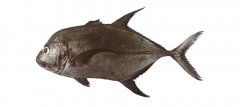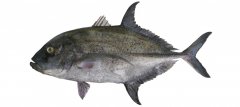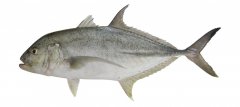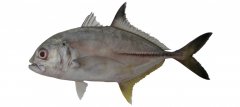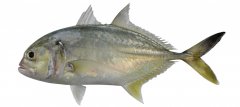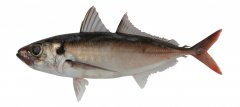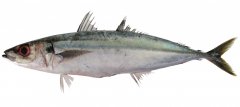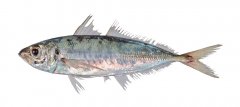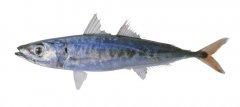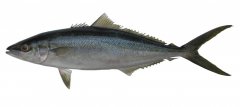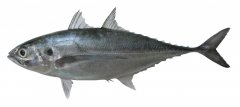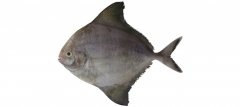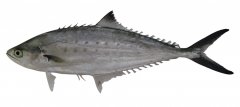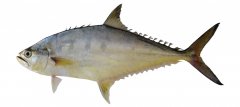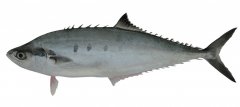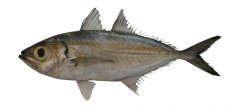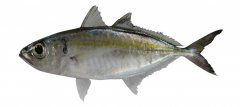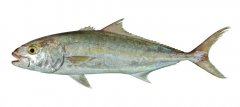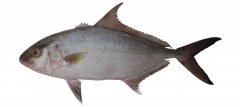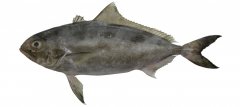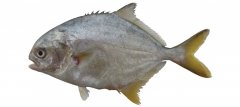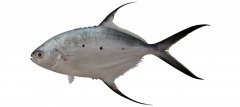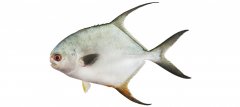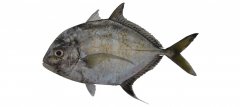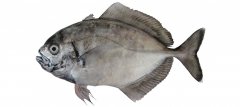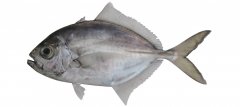Trevallies, queenfish, scads etc.
Characteristic features:
Keys:
Keys adapted from Smith-Vaniz, 19991.
Carangidae genera
-
- Posterior straight part of lateral line with hardened scutes (Fig. 1a); in adults, pectoral fins long and falcate, in most genera longer than head (about equal to head length in Selar, and shorter than head length in some Decapterus spp.) (Fig. 2a) 2
- No scutes in lateral line (only pored scales, not enlarged) (Fig. 1b); pectoral fins relatively short, shorter than head (about 50–90% of head length) (Fig. 2b) 15
-
- Pelvic fins absent in most specimens >100 mm fork length, if present positioned distinctly anterior to a vertical line through pectoral-fin base (Fig. 3a); soft anal-fin rays 35–39 Parastromateus niger
- Pelvic fins always present, not positioned distinctly anterior to a vertical through pectoral-fin base (Fig. 3b); soft anal-fin rays 15–31 3
-
- Scales on body minute, inconspicuous and embedded giving the impression of naked skin; in smaller fish, anterior soft rays of dorsal and anal fins filamentous (Fig. 4a) Alectis species
- Scales on body small but conspicuous, not embedded; in smaller fish, anterior soft rays of dorsal and anal fins not filamentous (Fig. 4b) 4
-
- Single detached terminal 2-rayed finlet in dorsal and anal fins (Fig. 6a); shoulder girdle (cleithrum) margin with 2 papillae, the lower papilla larger (Fig. 7a); maximum scute height less than eye diameter (Fig. 8a) Decapterus species
- Posterior soft dorsal- and anal-fin rays consisting of 6–10 detached finlets (Fig. 6b); shoulder girdle margin smooth (Fig. 7b); maximum scute height larger than eye diameter (Fig. 8b) Megalaspis cordyla
-
- Shoulder girdle (cleithrum) margin with a furrow ventrally, a large papilla immediately above it and a smaller papilla near upper edge (Fig. 9a) Selar species
- Shoulder girdle margin smooth (Fig. 9b) 7
-
- Lower jaw with a series of minute teeth; a prominent black opercular spot encroaching on shoulder (Fig. 10a); adipose eyelid well developed posteriorly (Fig. 11a) Selar crumenophthalmus
- Lower jaw with a few fine teeth in specimens <100 mm fork length, absent in adults; no black opercular spot (Fig. 10b); adipose eyelid poorly developed (Fig. 11b) Gnathanodon speciosus
-
- Tongue, roof and floor of mouth white, the rest dark (Fig. 12); anal-fin spines reabsorbed or reduced and immovable (Fig. 13a); no teeth on vomer or palatines Uraspis species
- Lining of mouth not distinctly black and white; anal-fin spines normal and movable (Fig. 13b); teeth present on vomer and palatines 10
-
- Fleshy adipose eyelid completely covering eye except for a vertical slit centred on pupil (Fig. 14a); terminal ray of dorsal and anal fins finlet-like, a little more separated from other rays but not detached, and about twice length of penultimate ray (Fig. 15a) Atule mate
- Fleshy adipose eyelid, if present, not well developed anteriorly, most of anterior half of pupil exposed (Fig. 14b); terminal ray of dorsal and anal fins not finlet-like (except terminal ray length 1.5 times the length of penultimate ray in large Alepes djedeba) (Fig. 15b) 11
-
- Adipose eyelid well developed on posterior half of eye only (Fig. 16a) Alepes species
- Adipose eyelid absent or only moderately developed (Fig. 16b) 12
-
- Upper jaw with an outer series of moderate to strong canines and an inner band of fine teeth (Fig. 17a); lower jaw with a single row of teeth Caranx species
- Dentition not as above (Fig. 17b) 13
-
- Belly with a deep median groove, accommodating pelvic fins, anus, and anal-fin spines (Fig. 18); pelvic fins conspicuously long and black, tip of appressed fins extending almost to origin of anal fin (Fig. 19a); curved lateral line short, chord of curved part of lateral line 1.5–2 times in straight part (Fig. 20a) Atropus atropos
- Belly without median groove; pelvic fins not conspicuously long and black (Fig. 19b); curved lateral line moderate in most species, with chord of curved part of lateral line <1.5 times in straight part (Fig. 20b) 14
-
- Gill rakers long, feather-like, and project into mouth alongside tongue (Fig. 21); total gill rakers 54–86 on first gill arch; lower jaw becoming prominent in large adults, with the angle of “chin” projecting beyond upper jaw (Fig. 22a) Ulua species
- Gill rakers of normal length and shape; total gill rakers 21–37 on first gill arch; shape of lower jaw not as above (Fig. 22b) Carangoides species
-
- Bases of soft dorsal and anal fins unequal in length, anal-fin base shorter and only about 45–70% of dorsal-fin base length (Fig. 23a); caudal-peduncle grooves present, dorsally and ventrally (Fig. 24a) 16
- Base of soft anal fin as long as, or only slightly shorter than, base of dorsal fin (Fig. 23b); no caudal-peduncle grooves (Fig. 24b) 19
-
- Terminal 2-rayed finlet present in dorsal and anal fins (Fig. 25a); upper jaw ending distinctly before eye (to below anterior margin of eye in young) (Fig. 26a) Elagatis bipinnulata
- No finlets in dorsal and anal fins (Fig. 25b); upper jaw ending below anterior margin of eye to posterior margin of eye (Fig. 26b) 17
-
- Upper jaw broadly rounded posteriorly and usually terminating below posterior margin of eye (Fig. 27a); gill rakers on first gill arch mostly consisting of rudiments, 4–10 total elements Seriolina nigrofasciata
- Upper jaw truncate or slightly rounded posteriorly and terminating below about anterior margin of eye to middle of eye (Fig. 27b); gill rakers on first gill arch mostly well developed, 11–29 total elements 18
-
- First dorsal fin with 4 or 5 spines; soft anal-fin rays 15–17; fleshy keel laterally on caudal peduncle well developed (Fig. 28a) Naucrates ductor
- First dorsal fin with 7 or 8 spines (anterior spines may become completely embedded in large individuals); soft anal-fin rays 18–22; fleshy keel on caudal peduncle absent (Fig. 28b) Seriola species
-
- Posterior soft dorsal- and anal-fin rays consisting of semi-detached finlets (Fig. 29a) Scomberoides species
- Posterior soft dorsal- and anal-fin rays not consisting of semi-detached finlets (Fig. 29b) Trachinotus species
Alectis species
-
- Profile of nape and head broadly rounded (Fig. 1a); suborbital depth relatively narrow, contained 1.7–3 times in upper jaw length (Fig. 2a); gill rakers on lower limb of first arch (excluding rudiments) 12–17 Alectis ciliaris
- Profile of nape and head somewhat angular (Fig. 1b); suborbital depth relatively broad, contained 0.8–1 times in upper jaw length (Fig. 2b); gill rakers on lower limb of first arch (excluding rudiments) 21–26 Scyris indica
Alepes species
-
- Upper jaw anteriorly with 2 irregular rows of short conical teeth, posteriorly inner surface of jaw paved with blunt teeth (Fig. 1a) Alepes kleinii
- Both jaws with a single row of numerous, comb-like teeth 2
-
- Interradial membranes of spinous dorsal fin black (Fig. 2a); total gill rakers 24–30 on first arch Alepes melanoptera
- Interradial membranes of spinous dorsal fin transparent to dusky (Fig. 2b); total gill rakers 32–47 on first arch 3
-
- Total gill rakers on first gill arch 38–47 (10–14 on upper limb, and 27–33 on lower limb); lateral line with 31–36 scales and 39–51 scutes (total 77–85); scutes larger (Fig. 3a); ultimate ray of dorsal and anal fins about 1.3–1.5 times the length of penultimate ray (Fig. 4a) Alepes djedaba
- Total gill rakers on first gill arch 32–38 (9–12 on upper limb, and 23–26 on lower limb; lateral line with 42–50 scales, 48–69 scutes (total 86–119); scutes smaller (Fig. 3b); ultimate and penultimate rays of dorsal and anal fins of equal length (Fig. 4b) Alepes vari
Carangoides species
-
- Second dorsal fin with a conspicuous black blotch or submarginal band (Fig. 2a); vomerine tooth patch anchor-shaped, with a long median posterior extension (Fig. 3a) Carangoides praeustus
- Second dorsal fin without a conspicuous black blotch or submarginal band (Fig. 2b); vomerine tooth patch without a distinct median posterior extension (Fig. 3b) 3
-
- Soft anal-fin rays 18–20; posterior margin of preopercle outlined in black, at least in adults (Fig. 4a); scutes 11–18 Craterognathus plagiotaenia
- Soft anal-fin rays 21–24; posterior margin of preopercle not black (Fig. 4b); scutes 20–30 Flavocaranx bajad
-
- Second dorsal fin with a conspicuous black blotch anteriorly; vomerine tooth patch anchor-shaped, with a long median posterior extension (Fig. 6a) Carangoides praeustus
- Second dorsal fin without a conspicuous black blotch; vomerine tooth patch without a distinct posterior extension (Fig. 6b) 6
-
- Naked area of breast extends posteroventrally well beyond origin of pelvic fins (Fig. 7a) Turrum fulvoguttatum
- Naked area of breast does not extend posteroventrally beyond origin of pelvic fins (Fig. 7b) 8
-
- Usually 5 or 6 distinct dusky bands on sides of adults and yellow or orange spots on sides, if present, small, numerous and mostly above lateral line; lips not papillose in adults Ferdauia ferdau
- Dark bands usually absent on sides of adults and several relatively large, oblong yellow spots with dark centres present mostly below lateral line; lips finely papillose in adults (Fig. 8) Ferdauia orthogrammus
-
- Straight part of lateral line slightly longer than curved part (Fig. 9a); scutes 37–45 Carangichthys oblongus
- Straight part of lateral line slightly shorter than curved part (Fig. 9b); scutes 16–38 10
-
- No small dark blotches on dorsum between bases of dorsal-fin rays (Fig. 10a) Turrum coeruleopinnatus
- Small dark blotches (becoming larger posteriorly) on dorsum between bases of dorsal-fin rays (Fig. 10b) Carangichthys dinema
-
- Profile of snout angular (Fig. 11a) and, in specimens >300 mm fork length, horizontal line from tip of snout distinctly below level of eye; soft anal-fin rays 21–26 (rarely 25 or 26); total gill rakers on first gill arch (including rudiments) 22–27 (6–8 on upper limb, and 17–21 on lower limb) Turrum fulvoguttatum
- Profile of snout moderately rounded (Fig. 11b) and, in specimens >300 mm fork length, horizontal line from tip of snout at or through level of eye; soft anal-fin rays 24–26 (usually 25); total gill rakers on first gill arch (including rudiments) 27–31 (7–9 on upper limb, and 19–22 on lower limb) Turrum gymnostethus
-
- Small area naked of scales anteriorly just above pectoral-fin base (Fig. 12a) 14
- Area anteriorly just above pectoral-fin base completely scaly (Fig. 12b) 15
-
- Total gill rakers on first gill arch (including rudiments) 32–38 (8–12 on upper limb, and 21–27 on lower limb); tongue greyish brown to brown Platycaranx malabaricus
- Total gill rakers on first gill arch (including rudiments) 27–31 (6–9 on upper limb, and 19–22 on lower limb); tongue white to pale grey (Fig. 13) Platycaranx talamparoides
-
- Small dark blotches (becoming larger posteriorly) on back between bases of dorsal-fin rays; naked area of breast typically does not extend posteroventrally beyond origin of pelvic fins (Fig. 14a); soft dorsal-fin rays 17–19 Carangichthys dinema
- Colour pattern not as above; naked area of breast extends posteroventrally well beyond origin of pelvic fins (Fig. 14b); soft dorsal-fin rays 18–23 16
-
- Total gill rakers on first gill arch (including rudiments) 31–37 Atropus armatus
- Total gill rakers on first gill arch (including rudiments) 20–27 17
-
- Adults with a steep dorsal head profile, and with a distinct break (“bump”) in profile in the interorbital region (Fig. 15a); 3–8 (usually 5–7) of central soft rays of dorsal and anal fins elongated in adult males (>170 mm fork length); eye diameter about equal to, or larger than snout length (Fig. 16a) Atropus hedlandensis
- Dorsal head profile not as steep in adults, and no distinct break (“bump”) in profile in the interorbital region (Fig. 15b); central soft rays of dorsal and anal fins not elongated in adult males; eye diameter slightly to much smaller than snout length (Fig. 16b) 18
-
- Dorsal profile of snout gently sloped, then abruptly vertical just above mouth cleft (Fig. 17a); soft dorsal-fin rays 18–20; soft anal-fin rays 15–17 Platycaranx chrysophrys
- Dorsal profile of snout not as above (Fig. 17b); soft dorsal-fin rays 20–23 (usually 22 or 23); soft anal-fin rays 16–20 (usually 18 or 19) Turrum coeruleopinnatus
Caranx species
-
- Body coloration essentially uniform grey to brown; lobe of dorsal fin relatively long, 2.3–5.3 times in fork length (Fig. 2a); profile of head relatively steep and angular (Fig. 3a) Caranx lugubris
- Body coloration not as above; lobe of dorsal fin contained 4.2–8.8 times in fork length (Fig. 2b); profile of head not noticeably steep and angular (Fig. 3b) 3
-
- Small black spots scattered on head and body (forming at ~160–220 mm fork length) (Fig. 4a); snout length 9.2–12.7 times in fork length (Fig. 5a); total gill rakers on first gill arch (including rudiments) 25–29 (usually 26 or 27), and total soft dorsal- and anal-fin rays 39–44 Caranx melampygus
- No small black spots scattered on head and body (Fig. 4b); snout length contained 13.1–18.4 times in fork length (Fig. 5b); total gill rakers on first gill arch (including rudiments) 22–25 (except 24–27 in C. heberi which has 34–38 total soft dorsal- and anal-fin rays) 4
-
- No small black spot present on upper margin of opercle (Fig. 6a); upper lobe of caudal fin frequently with distal half noticeably dark or black, especially in juveniles (Fig. 7a) Caranx heberi
- A small, black spot present on upper margin of opercle (Fig. 6b); upper lobe of caudal fin usually uniformly pigmented (Fig. 7b) 5
-
- In adults, dorsal-fin lobe without white tip (Fig. 8a); dorsal profile of head strongly convex and a black spot on upper margin of opercle, in adults, at least ½ the diameter of pupil (Fig. 9a) Caranx tille
- In adults, dorsal-fin lobe with white tip (Fig. 8b); dorsal profile of head moderately convex and black spot on upper margin of opercle, its size in adults no larger than twice the diameter of pupil (Fig. 9b) Caranx sexfasciatus
-
- Naked area of breast uninterrupted to naked base of pectoral fins (Fig. 10a); curved part of lateral line short, chord of curved part 2.5–3.3 times in straight part (Fig. 11a); scutes larger (Fig. 12a) Caranx bucculentus
- Naked area of breast separated from naked base of pectoral fins by a broad band of scales (Fig. 10b); curved part of lateral line moderate, with chord of curved part contained less than 1.5 times in straight part (Fig. 11b); scutes smaller (Fig. 12b) 7
-
- Total gill rakers on first gill arch (including rudiments) 20–24; body silvery to black; in specimens >150 mm fork length, body depth 2.5–3.2 times in fork length (Fig. 13a) Caranx ignobilis
- Total gill rakers on first gill arch (including rudiments) 23–30 (rarely 23); body bronze to yellow-green; in specimens >150 mm fork length, body depth 2.7–3.8 times in fork length (Fig. 13b) 8
-
- Total soft dorsal- and anal-fin rays 34–38 (rarely 38); upper lobe of caudal fin frequently with distal half noticeably dark or black (especially in juveniles), and posterior margin of lower lobe without a narrow white border (Fig. 14a); no pale spot on shoulder just behind posterodorsal margin of opercle (Fig. 15a); adults without small black spots (Fig. 16a) Caranx heberi
- Total soft dorsal- and anal-fin rays 37–41 (rarely 37); upper lobe of caudal fin usually uniformly pigmented, and posterior margin of lower lobe with a narrow white border (Fig. 14b); in life a conspicuous pale spot, approximately the diameter of pupil, on shoulder just behind posterodorsal margin of opercle (Fig. 15b); adults with small black spots on body above lateral line (forming at ~250 mm fork length) (Fig. 16b) Caranx papuensis
Decapterus species
-
- Posterior end of upper jaw concave above, rounded and produced below (Fig. 1a); straight part of lateral line with 14–29 scales (Fig. 2a) Decapterus macrosoma
- Posterior end of upper jaw straight above, straight to slightly concave below (Fig. 1b); straight part of lateral line with 0–15 scales (except 18–39 scales in D. macarellus) (Fig. 2b) 2
-
- Posterior end of upper jaw noticeably slanted anteroventrally; straight part of lateral line with 18–39 scales and 24–40 scutes (total 52–67) (Fig. 3a); pectoral fins usually shorter in adults, 58–72% head length (Fig. 4a); oral valve (membrane) at symphysis of upper jaw conspicuously white Decapterus macarellus
- Posterior end of upper jaw not as noticeably slanted anteroventrally; straight part of lateral line with 0–10 scales and 30–40 scutes (total 30–49) (Fig. 3b); pectoral fins usually longer in adults, 71–105% head length (except 62–83% in D. tabl) (Fig. 4b); oral valve (membrane) at symphysis of upper jaw dusky or transparent 3
-
- Scutes relatively small; curved part of lateral line with 61–73 scales; straight part of lateral line with 4–12 anterior scales; total lateral-line scales and scutes (excluding scales on caudal fin) 103–118 (Fig. 5a); caudal fin red Decapterus tabl
- Scutes relatively large; curved part of lateral line with 42–62 scales; straight part of lateral line with 0–4 anterior scales; total lateral-line scales and scutes (excluding scales on caudal fin) 77–102 (Fig. 5b); caudal fin dusky or red 4
-
- Caudal fin hyaline to dusky (Fig. 6a); gill rakers on lower limb of first gill arch usually 32–39; soft anal-fin rays (including finlet) 25–29 (rarely 25); eye usually smaller Decapterus russelli
- Caudal fin red (Fig. 6b); gill rakers on lower limb of first gill arch usually 26–32; soft anal-fin rays (including finlet) 22–26 (rarely 26); eye usually larger Decapterus kurroides
Scomberoides species
-
- Total gill rakers on first gill arch 8–15; scales on midbody below lateral line broadly oblong or blunty lanceolate (Fig. 1a); lobe of dorsal fin uniformly pigmented (Fig. 2a) 2
- Total gill rakers on first gill arch 21–27; scales on midbody below lateral line sharply lanceolate or needle-like (Fig. 1b); distal half of dorsal-fin lobe abruptly and heavily pigmented (Fig. 2b) 3
-
- Upper jaw extends well beyond posterior margin of eye, especially in adults (Fig. 3a); in adults, teeth of inner and outer rows in lower jaw subequal in size (Fig. 4a); large oval blotches above or touching lateral line (Fig. 5a) Scomberoides commersonnianus
- Upper jaw extends slightly beyond posterior margin of eye (Fig. 3b); in adults, inner row of teeth in lower jaw distinctly larger than those in outer row (Fig. 4b); vertically elongate blotches intersecting lateral line (Fig. 5b) Scomberoides tala
-
- Scales on mid-body below lateral line sharply lanceolate (Fig. 6a); in adults, upper jaw extends to or slightly beyond posterior margin of eye (Fig. 7a); a double series of 6–8 dusky, roundish blotches above and below lateral line, occasionally connected by narrow isthmus (Fig. 8a) Scomberoides lysan
- Scales on mid-body below lateral line slender, needle-like (Fig. 6b); in adults, upper jaw does not extend to posterior margin of eye (Fig. 7b); oval or vertically oblong dark blotches, the first 4 or 5 intersecting lateral line (Fig. 8b) Scomberoides tol
Selar species
-
- Curved part of lateral line with 48–56 scales; curved part of lateral line moderate, with chord of curved part contained 0.7–1.2 times in straight part (Fig 1a); scutes smaller (Fig. 2a) Selar crumenophthalmus
- Curved part of lateral line with 21–24 scales; curved part of lateral line short, chord of curved part contained 2.1–3 times in straight part (Fig. 1b); scutes larger (Fig. 2b) Selar boops
Seriola species
-
- In adults, length of dorsal-fin lobe about 1.3–1.6 times longer than pectoral fins (Fig. 1a) and 18–22% of fork length; in specimens >200 mm fork length, total gill rakers on first gill arch (excluding rudiments) 22–26 Seriola rivoliana
- In adults, length of dorsal-fin lobe about equal to, or slightly longer than pectoral fins (Fig. 1b) and 13–18% of fork length; in specimens >200 mm fork length, total gill rakers on first gill arch (excluding rudiments) 11–19 Seriola dumerili
Trachinotus species
-
- In adults, all spots equal to, or smaller than eye diameter (Fig. 2a); gill rakers on lower limb of first gill arch (including rudiments) 15–19; vomerine tooth patch chevron-shaped (Fig. 3a) Trachinotus baillonii
- In adults, anterior 2 spots larger than eye diameter and at least two-thirds of spot above lateral line (Fig. 2b); gill rakers on lower limb of first gill arch (including rudiments) 11–15; vomerine tooth patch oval or narrowly triangular (Fig. 3b) Trachinotus botla
-
- Soft dorsal- and anal-fin rays 21–23 and 19–21, respectively; body often with a black oval-shaped blotch in axillary base under pectoral fins Trachinotus africanus
- Soft dorsal- and anal-fin rays 18–20 and 16–18, respectively; body uniformly pigmented in axillary base under pectoral fins Trachinotus blochii
Ulua species
-
- Total gill rakers on first gill arch 54–61 (16–21 on upper limb, and 37–41 on lower limb); tongue with central band of villiform teeth; in specimens <150 mm fork length, first anal-fin ray produced but not filamentous, not extending beyond caudal peduncle (Fig. 1) Atropus aurochs
- Total gill rakers on first gill arch 74–86 (23–27 on upper limb, and 51–61 on lower limb); tongue without central band of villiform teeth; in specimens <150 mm fork length, first anal-fin ray filamentous, extending beyond caudal peduncle Atropus mentalis
Uraspis species
-
- Naked area of breast extends uninterrupted to naked base of pectoral fins (Fig. 1a); scales in curved part of lateral line 61–82 (Fig. 2a) Uraspis uraspis
- Naked area of breast separated from naked base of pectoral fins by a broad band of scales (Fig. 1b); scales in curved part of lateral line 48–66 (Fig. 2b) Uraspis secunda
Species:
References:
- Smith-Vaniz, W.F. Carangidae in: Carpenter, K, Niem, V. Species identification guide for fisheries purposes. The living marine resources of the western central Pacific. Bony fishes part 2 (Mugilidae to Carangidae). Rome: FAO; 1999;4.
×
![]()
